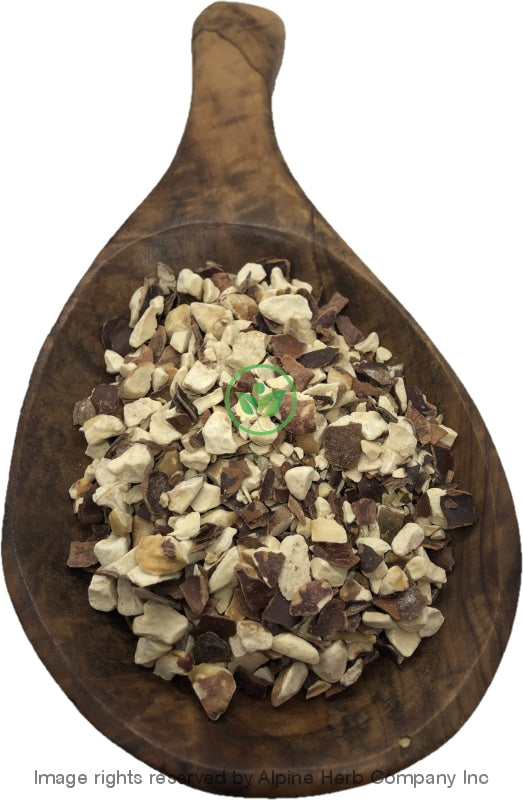Horse Chestnut Cut Alpine Herb Company Inc.
$ 8,99 $ 5,39
Botanical Name: Aesculus hippocastanum
Common Name:
- English: Common horse chestnut
- Also, known as: Aescule, Abu farwat el hhussan, Baloot, Castagna amare, Castagna cavallina, Marronier d’Inde, Naru, Paardekastanje,Pu, Pferdekastanie, Qastanah baria, Castagna di cavalle, Castagno d’India, Castan, Castano de Indias, Castandas da India, Castanheiro da India, Castano de Indias, Chata, Eschilo,Gemeine Rosskastanie, Hippocastani semen, Horse chestnut, Karu, Rosskastanie, Seiyo-tochinoki, Eiyoutochinoki, Semen castaneae Equinae, shahbalout-e hendi, Vadgesztenyemag, Weisse Rosskastanie, Wilde kastanje, Wilde kest, Chataignier de cheval, Chataignier de mer, Conqueror tree, Custul, and Gemeine Kastanie.
Habitat: Western Asia. Now widely cultivated in Europe, and the USA.
Origin: Poland
Harvested: Wild or cultivated
Parts Used: Seed
General Information:
Aesculus hippocastanum, is a deciduous tree, a mature tree can reach 50-70 feet tall and 5-7 feet in circumference with large sticky buds and dense, broad, usually orbicular, or occasionally pyramidal, crown. The large leaves are palmately compound with five to seven leaflets, spreading like fingers from the palm of the hand and have their margins finely toothed, up to 20cm long and 10 cm wide, with 15–20 cm long petioles, median leaflet largest, outer leaflets much smaller. All over the small branches may be found the curious marks in the shape of minute horse-shoes, from which, perhaps, the tree gets its name. White flowers grow in erect panicles have 5 petals with an orbicular limb, imbricate at the margins, white, with a yellow spot at the base which later turns pink; arranged in erect dense panicles up to 20– 30cm long. Several fruits develop on each panicle, and the seeds, or conkers, are brown nut, with a very shining, polished skin, showing a dull, rough, pale-brown scar where it has been attached to the inside of the seed-vessel, sheathed in a spiky green capsule, protected with short spines, which splits into three valves when it falls to the ground and frees the nut.
Trees are widely cultivated in streets and parks throughout temperate regions. The tree is chiefly grown for ornamental purposes, in towns and private gardens and in parks, and forms fine avenues in the spring, when the trees are in full bloom, present a beautiful sight. Harvest the seed and husks in the fall. The Horse Chestnut is generally raised from the nuts, which are collected in the autumn and sown in the early spring. The nuts should be preserved in the sand during the winter, as they may become moldy and rot. It steeped in water, they will germinate more quickly. In Britain and Ireland, the seeds are used for the popular children’s game conkers. The game grew in popularity in the 20th century and spread beyond England.
How to use:
Decoctions are suitable for roots, barks, large seeds & berries, and other dense material. The simple way to make decoction is, in a saucepan, add 1 tablespoon of dried herbs to 1 cup of water. Bring the water to boil, reduce heat and simmer for 30-60 minutes. Strain and squeeze out as much as liquid as possible and enjoy!
Tips:
- You can sweeten your herbal decoctions with bit of honey, natural fruit juice, stevia leaves powder and or licorice root powder.
Precautions:
You should consult with a qualified healthcare practitioner before using any herbal products, particularly if you are pregnant, nursing, or on any medications.
All information on this website is for educational purposes ONLY.
This information has not been evaluated by Health Canada.
This information is not intended to diagnose, treat, cure, or prevent any disease.
| Unit Size | 100g, 200g, 400g, 1kg |
|---|
Prompt shipping and expert packing
Thanks to our longstanding association with UPS FedEx DHL as well as other leading global carriers, we can offer a variety shipping options. Our warehouse staff is highly trained and will be able to pack your goods in accordance with our precise and exact specifications. Your items will go through an exhaustive examination before they will be securely packaged before being delivered. We ship to hundreds of thousands of customers daily in different countries. This is a sign of our determination to become the largest online retailer worldwide. Warehouses and distribution centers are located throughout Europe as well as in the USA.
Note that orders containing multiple items are processed according to the particular item.
We will thoroughly inspect all items ordered before shipping. Most orders are shipped within 48 hours. The delivery time will be between 3 and 7 working days.
Returns
The stock market is always changing. It's not entirely managed by us since we're involved with several entities, including the factory and the storage. Therefore, the actual inventory could fluctuate at any moment. Please be aware that it is possible that your order could be out of stock after you've placed your order.
Our policy lasts for 30 days. If it's been more than 30 days since the date you purchased your item We're sorry to say that we can't offer you a full exchange or refund.
You can only return a product if it is unused and still in the same state as when you received it. The item should be in the original packaging.


































